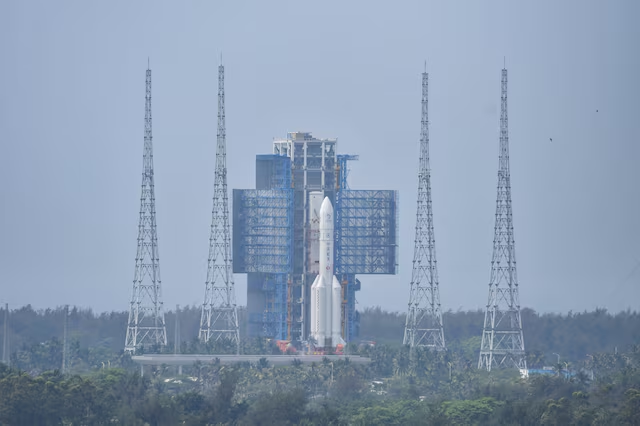China would launch a robotic spacecraft on a round trip to the back side of the moon in the coming days, Reuters reported.
The journey will be the first of three technically challenging missions paving the way for the first landing of a Chinese crew and the establishment of a base at the lunar south pole.
Since the first Chang’e mission in 2007, named after the mythical Chinese moon goddess, China has made great strides in lunar exploration, narrowing the technological gap with the United States and Russia.
In 2020, China brought back samples from the near side of the moon for the first time in over forty years. The mission verified that the country could safely return an unmanned spacecraft to Earth from the lunar surface.
China is expected to launch Chang’e-6 this week using the 2020 mission’s backup spacecraft and collect soil and rocks from the moon’s back side, which is permanently facing away from Earth.
With no direct line of sight to Earth, Chang’e-6 will rely on the recently launched relay satellite orbiting the moon. The same satellite will support the unmanned Chang’e-7 and 8 missions in 2026 and 2028 respectively, when China will begin exploring the south pole in search of water and building a rudimentary outpost with Russia.
China aims to send its astronauts to the moon by 2030.
However, Beijing’s polar plans raised concerns at NASA. Administrator Bill Nelson has repeatedly warned that China will claim any water resources as its own. Beijing claims it remains committed to working with all nations to build a “shared” future.
Chang’e-6 will carry payloads from France, Italy, Sweden and Pakistan, while Chang’e-7 will deliver payloads from Russia, Switzerland and Thailand. The United States will not participate as US law prohibits NASA from any co-operation, direct or indirect, with China.
Under a separate NASA-led Artemis programme, US astronauts will land near the south pole in 2026, becoming the first humans on the moon since 1972. Clive Neal, professor of planetary geology at the University of Notre Dame, stated:
International co-operation is key [to lunar exploration]. It’s just that China and the US aren’t co-operating right now. I hope that will happen.
Chang’e-6 will attempt to land on the northeast side of the huge South Pole-Aitkin Basin, the oldest known impact crater in the solar system. The southernmost landing in history was made in February by IM-1, a joint mission between NASA and the Texas-based private firm Intuitive Machines.
Scientists call the south pole the “golden belt” of lunar exploration.
Polar ice could support long-term research bases without relying on expensive resources transported from Earth. India’s Chandrayaan-1 spacecraft, launched in 2008, confirmed the presence of ice inside polar craters.
So far, all lunar samples taken by the United States and the former Soviet Union in the 1970s and by China in 2020 have been collected from the lunar near side where volcanism has been much more active. After a hasty landing, Chang’e-6 will collect about 2 kilograms (4.4 pounds) of samples with the help of a mechanical scoop and drill. Leonard David, author of ‘Moon Rush: The New Space Race’, claimed:
The robotic reach to the Moon’s far side, and bringing specimens back to Earth, helps fill in the blanks about the still-murky origin of our Moon.
